Prof. Dr Jan Pajak Sightings of UFO vehicles and devices - Totalizm
Prof. Dr Jan Pajak Sightings of UFO vehicles and devices - Totalizm
Prof. Dr Jan Pajak Sightings of UFO vehicles and devices - Totalizm
Create successful ePaper yourself
Turn your PDF publications into a flip-book with our unique Google optimized e-Paper software.
R-24<br />
always wait patiently nearby. For this reason people who investigate these mascots have<br />
huge difficulties with documenting reliably, that these mascots in fact do exist.<br />
One <strong>of</strong> the best known such blood sucking "mascots" <strong>of</strong> <strong>UFO</strong>nauts is a creature<br />
recently called with a popular name "chupacabra". In 1975, 1995, <strong>and</strong> 1996, it was let loose<br />
many times on a densely populated isl<strong>and</strong> <strong>of</strong> Puerto Rico, where quite a detailed observation<br />
<strong>of</strong> it was carried out. In 1996 attacks <strong>of</strong> this creature noticed also in several areas <strong>of</strong> Mexico,<br />
on the area <strong>of</strong> southern USA (i.e. Miami on Florida, Tuckson in Arizona), <strong>and</strong> in San José,<br />
Costa Rica. On Friday, 3 October 2003 one <strong>of</strong> these monsters was also observed in New<br />
Zeal<strong>and</strong> - about what I write near the end <strong>of</strong> this subsection. Many press articles was<br />
published about "chupacabras". This summary <strong>of</strong> attributes <strong>of</strong> these monsters is mainly based<br />
on the extensive article [1R4.2] by Linda Moulton Howe, "Chupacabras - The Mysterious<br />
Bloodsuckers", which appeared in bimonthly Nexus (P.O. Box 30, Mapleton, Qld 4560,<br />
Australia), issue from June-July 1997, Vol. 4, No. 4, pages 53 to 57. But I utilised here also<br />
other sources which were in my disposal. In Polish press the following articles appeared about<br />
them: [2R4.2] ""Chupacabras - blood suckers" (in Polish: "Chupacabras - krwiopijca")<br />
published in Journal Nieznany Swiat, number 9/1998, pages 14-15; [3R4.2] "Invisible<br />
predators" (in Polish: "Niewidzialni drapiezcy"), Nieznany Swiat, number 11/1998, pages 32 to<br />
34; [4R4.2] "Vampire from Puerto Rico" (in Polish: "Wampir z Puerto Rico") from Nieznany<br />
Swiat, number 11/1998, pages 34 to 37; [5R4.2] "Chupacabras in <strong>of</strong>fensive" (in Polish:<br />
"Chupacabry w <strong>of</strong>ensywie"), from quarterly <strong>UFO</strong>, number 1 (33), <strong>Jan</strong>uary-March (styczenmarzec)<br />
1998, pages 34 to 42. Unfortunately, not everything that is presented in these articles<br />
coincides with my own experience <strong>and</strong> findings. Thus while reading descriptions that are<br />
presented in further parts <strong>of</strong> this subsection, one needs to remember that for sure there is a<br />
number <strong>of</strong> different races <strong>of</strong> these blood sucking mascots <strong>of</strong> <strong>UFO</strong>nauts, similarly like people<br />
have many different breeds <strong>of</strong> dogs that mutually differ by appearance <strong>and</strong> by colour. These<br />
races <strong>of</strong> chupacabras are periodically let loose on Earth by <strong>UFO</strong>nauts, so that they can "hunt".<br />
In turn on Earth all <strong>of</strong> them are currently classified into the same group <strong>of</strong> "chupacabras". But<br />
in this subsection I only describe one <strong>of</strong> these races, which I had a doubtful pleasure to<br />
encounter in person in my teenage years.<br />
The current name "chupacabra" used for these monsters was formed in Puerto Rico<br />
during a wave <strong>of</strong> attacks <strong>of</strong> this creature that took place in 1995 <strong>and</strong> 1996. This name<br />
originates from two Spanish words "chupar" ("suck") <strong>and</strong> "cabras" ("goats"). But in old times<br />
these monsters were also known, only that under different names. For example in 1925 they<br />
were observed in New Jersey, where they were called "Jersey Devil". In folklore from Pol<strong>and</strong><br />
they are frequently identified with devils that took shape <strong>of</strong> dogs, or with so-called<br />
"werewolves". In antiquity <strong>and</strong> medieval ages they were known under the name <strong>of</strong> "griffins"<br />
<strong>and</strong> presented in drawings as small winged lions st<strong>and</strong>ing on back legs. In this subsection I<br />
am also going to call them "griffins", although everywhere that I use the name "griffin" I also<br />
have in mind the creature now called "chupacabra".<br />
Griffins appear in many races, that mutually differ with size, colour <strong>of</strong> feather, <strong>and</strong><br />
various anatomic details (e.g. having or lacking a tail). A number <strong>of</strong> their subsequent races<br />
that <strong>UFO</strong>nauts let loose on Earth seems to be almost the same wide as a number <strong>of</strong> breeds <strong>of</strong><br />
dogs that currently people keep on Earth. Griffins observed so-far usually were sizes <strong>of</strong> a dog,<br />
with a body long at around 0.6 to 1 meter. They smell quite intensely with mud <strong>and</strong> wind, thus<br />
their presence sometimes can be noticed in darkness firstly by a smell before they can be<br />
seen visually. Their appearance slightly resembles a small lion, or panther. Frequently they<br />
move on back legs only, in an uplifted position. They have a split tongue like our snakes. Most<br />
frequently they do not have a tail, although there seem to be also griffins with a tail. (Perhaps<br />
all <strong>of</strong> them are born with tails, but <strong>UFO</strong>nauts cut tails in some <strong>of</strong> them similarly like people do<br />
this to some breeds <strong>of</strong> dogs.) Their body is covered with something, that in front part looks like<br />
a fur, while on the back resembles feather. (I personally believe that these are small feathers.)<br />
The colour <strong>of</strong> this fur/feathers usually is completely black. But in several cases this fur/feather<br />
was also patched or dotted in colours: grey, brown, brick-like, <strong>and</strong> even orange <strong>and</strong> pink.


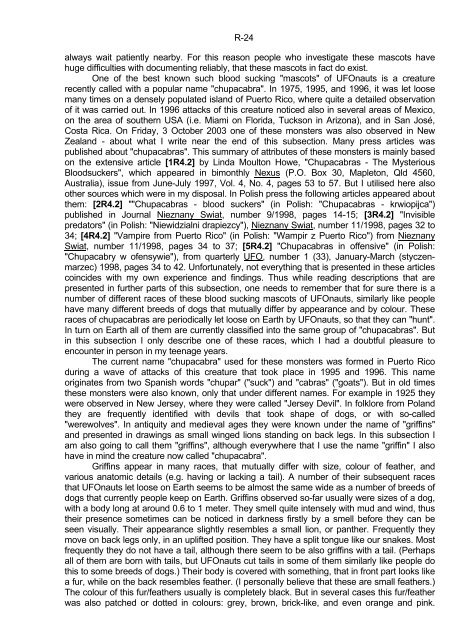
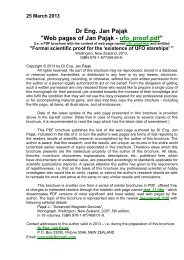


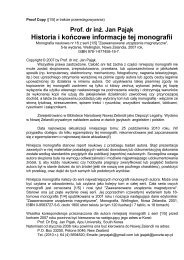
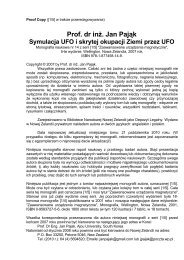


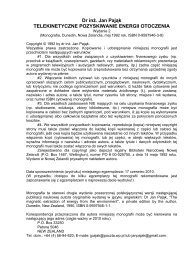
![[1/4p]: PDF - Totalizm](https://img.yumpu.com/45003232/1/184x260/1-4p-pdf-totalizm.jpg?quality=85)

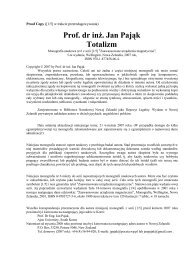
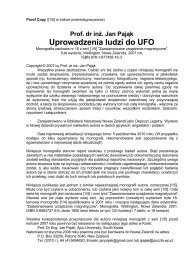
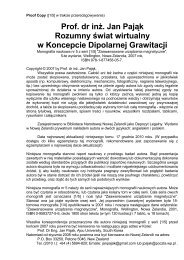
![[1/4p]: PDF - Totalizm](https://img.yumpu.com/39351336/1/184x260/1-4p-pdf-totalizm.jpg?quality=85)
